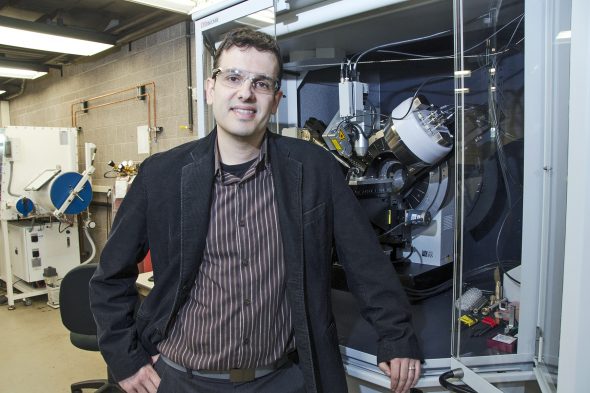Scientists a step closer to discovering better batteries

Magnesium ions could replace lithium ions used in high-voltage batteries, says UIC researcher Jordi Cabana. — Photo: Joshua Clark
The race is on around the world for scientists striving to develop a new generation of batteries that perform beyond the limits of the current lithium-ion based battery.
UIC researchers have made a significant step toward a battery that could outperform the technology used in electric cars such as the Chevy Volt.
They replaced the lithium ions (each carrying a single positive charge) with magnesium ions (which have a plus-two charge) in battery-like chemical reactions, using an electrode with a structure like those in many of today’s devices.
“We hope that this work will open a credible design path for a new class of high-voltage, high-energy batteries,” said Jordi Cabana, assistant professor of chemistry and principal investigator on the study.
The research is part of the Joint Center for Energy Storage Research — a Department of Energy Innovation Hub led by Argonne National Laboratory — that seeks revolutionary advances in battery performance.
Every battery consists of a positive and negative electrode and an electrolyte. The electrodes exchange electrons and ions, which are usually of positive charge. Only the ions flow through the electrolyte, an electric insulator that forces the electrons to flow through the external circuit to power the vehicle or device.
To recharge the battery, the exchange is reversed. But the chemical reaction is not perfectly efficient, which limits how many times the battery can be recharged.
“The more times you can do this back and forth, the more times you will be able to recharge your battery and still get the use of it between charges,” Cabana said.
“We want to maximize the number of electrons moved per ion, because ions distort the structure of the electrode material when they go in or leave. The more the structure is distorted, the greater the energy cost of moving the ions back, the harder it becomes to recharge the battery.
“Like a parking garage, there are only so many spaces for the cars,” he added. “But you can put a car in each space with more people inside without distorting the structure.”
Establishing that magnesium can be reversibly inserted into electrode material’s structure brings researchers one step closer to a prototype, Cabana said.
“It’s not a battery yet, it’s a piece of a battery, but with the same reaction you would find in the final device,” he said.
The study is online in advance of print in the journal Advanced Materials.
Chunjoong Kim, postdoctoral research associate in chemistry, was first author of the paper. Co-authors are Tanghong Yi and Ryan Bayliss, chemistry; Patrick Phillips and Robert Klie, physics; Baris Key, Sang-Don Han, Zhengcheng Zhang and Anthony Burrell, Argonne; Dennis Nordlund, SLAC National Accelerator Laboratory; Meinan He, Argonne and Worcester Polytechnic Institute; and Young-Sang Yu, UIC and Lawrence Berkeley National Laboratory.
Categories
Topics
